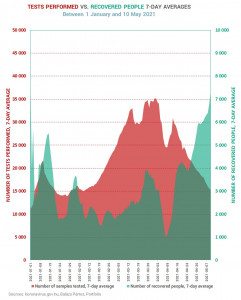Pandemic seen receding in Hungary - What is behind the statistics?

Since our last look at the correlation between the number of daily tests and all the other COVID-19 statistics (coronavirus patients in hospitals, on ventilators, recovered, active cases) a lot of interesting and rather shocking things happened.
Three of the following four charts show that the fewer tests authorities perform, the higher the number of recovered people goes. Just like before, only this time it is beginning to look ridiculous.
The fourth chart shows how hospitals are making room for ‘regular’ patients and keep sending home recovered COVID-19 patients or those that no longer need hospital care and can continue their recovery at home.
Minister of Human Capacities Miklós Kásler has announced the official re-opening of health care for Wednesday, and all the evidence suggests that the health care system is indeed trying to return to business as usual.
The top two charts show the same set of figures, only the yellow area on the second one, depicting the number of people that recovered from COVID-19, is from top to bottom.
The trend on the second one is clear: the more tests they perform (blue), the lower the number of recoveries go (yellow). The same phenomenon can be seen on the first chart, by the way, only in the form of ‘ridges’ running parallel with each other up to April. Then there’s a sharp divergence. One of the ridges becomes a precipice, the other turns into a steeply ascending cliff.


This abrupt change is shown on the third chart by the yellow line skyrocketing to over 47% from 5% over a single month.
Our hypothesis is that most of the daily tests are done samples taken from people waiting to be discharged from hospitals, while authorities are also trying to perform as few tests as possible, i.e. only those that show severe symptoms get tested for COVID-19.

The fourth chart is supposed to support our hypothesis that hospitals are discharging as many (recovered) COVID-19 patients as possible in order to make room for people with other diseases.
People in hospital with coronavirus infection make up only 2% of active cases
, which is extremely low ratio, especially in view of the fact that the UK variant (B.1.1.7) is not only more infectious but also causes more severe symptoms. Only two months ago, 6 to 7% of active cases were in hospital.
What could be behind this? Maybe the process of discharging COVID-19 patients and reporting them as recovered has become extremely slow. But then why don’t authorities perform additional 15,000 tests per day on (recovered) patients awaiting their discharge papers to improve the stats?
Also note that about 12% of people in hospitals with coronavirus infection have required mechanical ventilation over the past month, while the ratio was around half of that between November 2020 and February 2021. The conclusion is that only those get admitted to COVID-19 wards who are in serious condition, and
this is why the number of deaths per day remains around 100, while it was “only” double when four times as many (more than 12,000) people were in hospitals with coronavirus infection.

COVID-19 remains the deadliest in Hungary in terms of deaths per one million population (2,987).
Overall, the objective is to make sure hospitals fulfil their original function and treat all kinds of sicknesses and conditions. This is why they perform very few tests and mostly on those that have recovered, and this is why only the most serious COVID-19 cases are admitted and remain in hospital. The idea behind this is that an increasing percentage of the population is now vaccinated against COVID-19 (25% with the second dose and about 44% with the first), and there are those that have contracted the infection and recovered who are also immune for a while. This is supposed to prevent a fourth wave in the pandemic.
The problem is that more than half of the population have not received their shots, and only 4.9 million registered for a COVID-19 vaccine, 80% of whom have already been inoculated.

Need a knee replacement? No problem. Come back in 17 months, please.
Local daily Népszava reported on Monday that the load on health care staff is not letting up. Hospitals have to rev up vaccinations, maintain their COVID-19 wards, let doctors and nurses take off a couple of days to rest, and restart all other care for the population.
There’s simply not enough manpower or capacity for all this
, said one of the hospital chiefs. Hospitals admitted 30 to 40% fewer patients during the pandemic and 80% of them had coronavirus. Under a ministerial order COVID-19 wards must be maintained, but nurses and doctors treating patients there must not be involved in treating other patients.
According to the National Health Insurance Fund Management’s (NEAK) website, 1,123 people wait for cardiac catherization, about 6,000 for hip replacement, with the waiting time up at 427 days from 406 days, and 1,400 to 1,500 for spinal surgery. The actual number of people waiting for these procedures could be a lot higher, as the website operates with a 2-3 week delay. And there are those that got ill during the pandemic but never went to a doctor. The average waiting time for a cataract surgery grew sixfold to 243 days. As of 6 May, a total of 11,064 people were waiting for their surgery, with an average waiting period of 253 days, according to the NEAK website. At the end of March there were 6,922 people waiting for a knee replacement, against 5,712 on 9 November 2020. The estimated waiting period grew to 499 days from 145. As of 6 May, 7,140 people awaited knee replacement, with an 510-day waiting time.
“Pole and Hungarian, two good friends”
Finally, just an interesting phenomenon. A kind of a puzzle, if you will. How is it possible that the number of new daily COVID-19 cases per one million population has recently been almost identical in Hungary and Poland?
The population of Hungary is about 9.7 million. Poland’s population is 37.8 million.
Yet, here it is:

Here's the same stats for the Visegrad Four, showing rather different patterns for Czechia and Slovakia.
Here's Hungary versus Czechia:
And Hungary versus Slovakia:
So, what’s the deal here? It’s mind-boggling.

Balázs Pártos co-authored this analysis.
Cover photo: Getty Images









